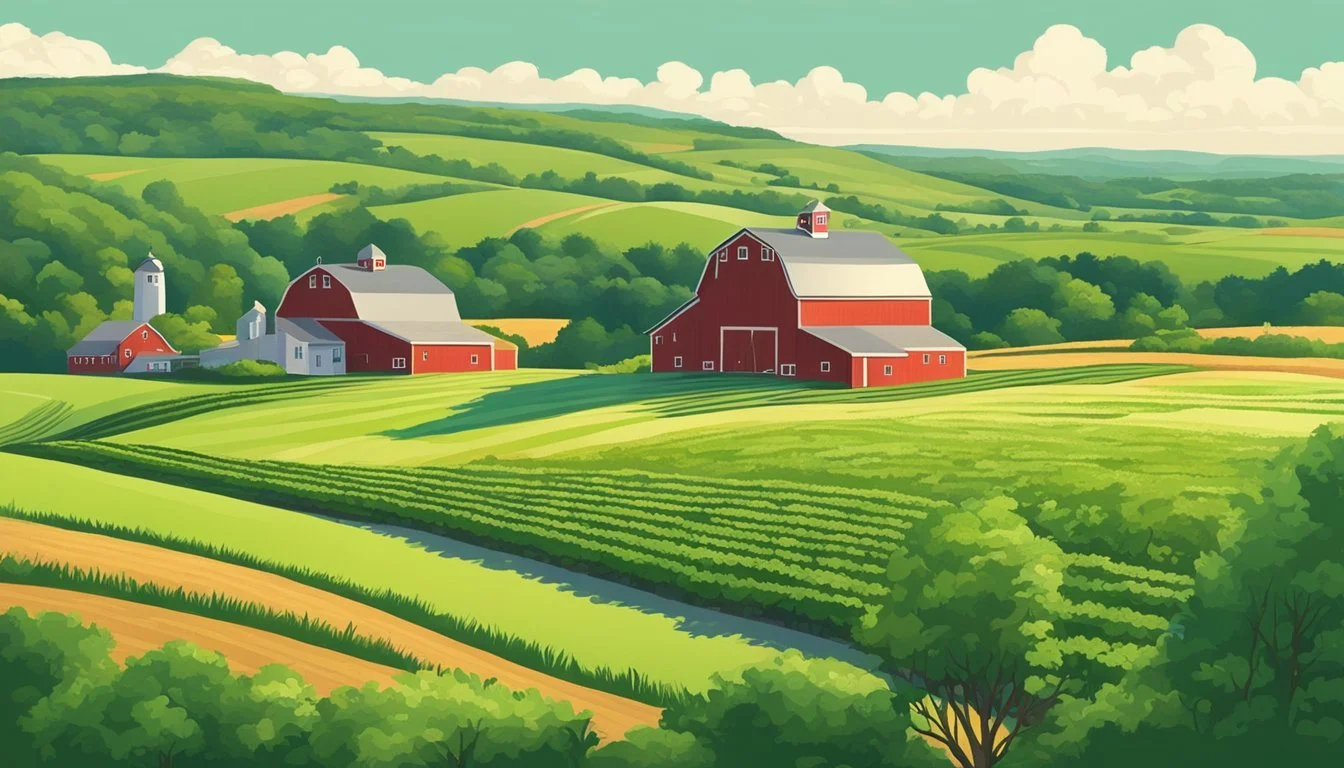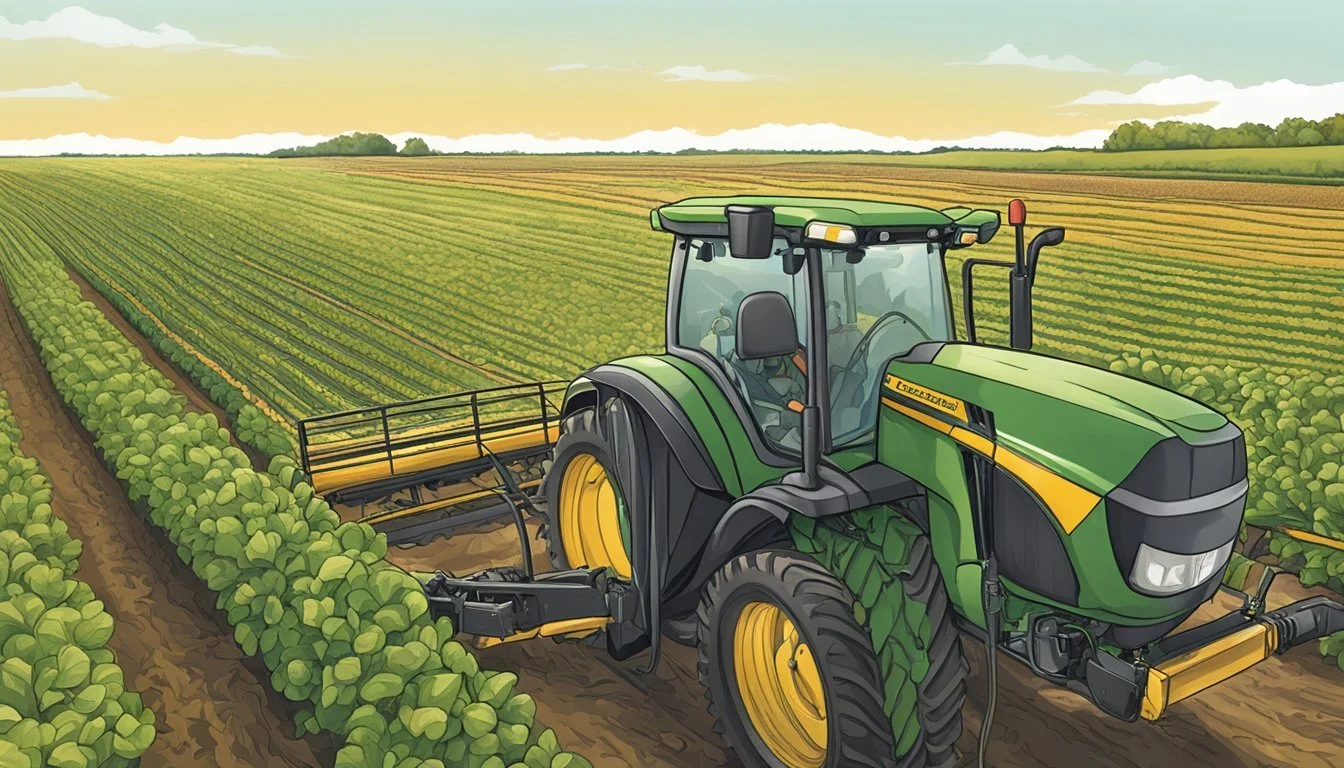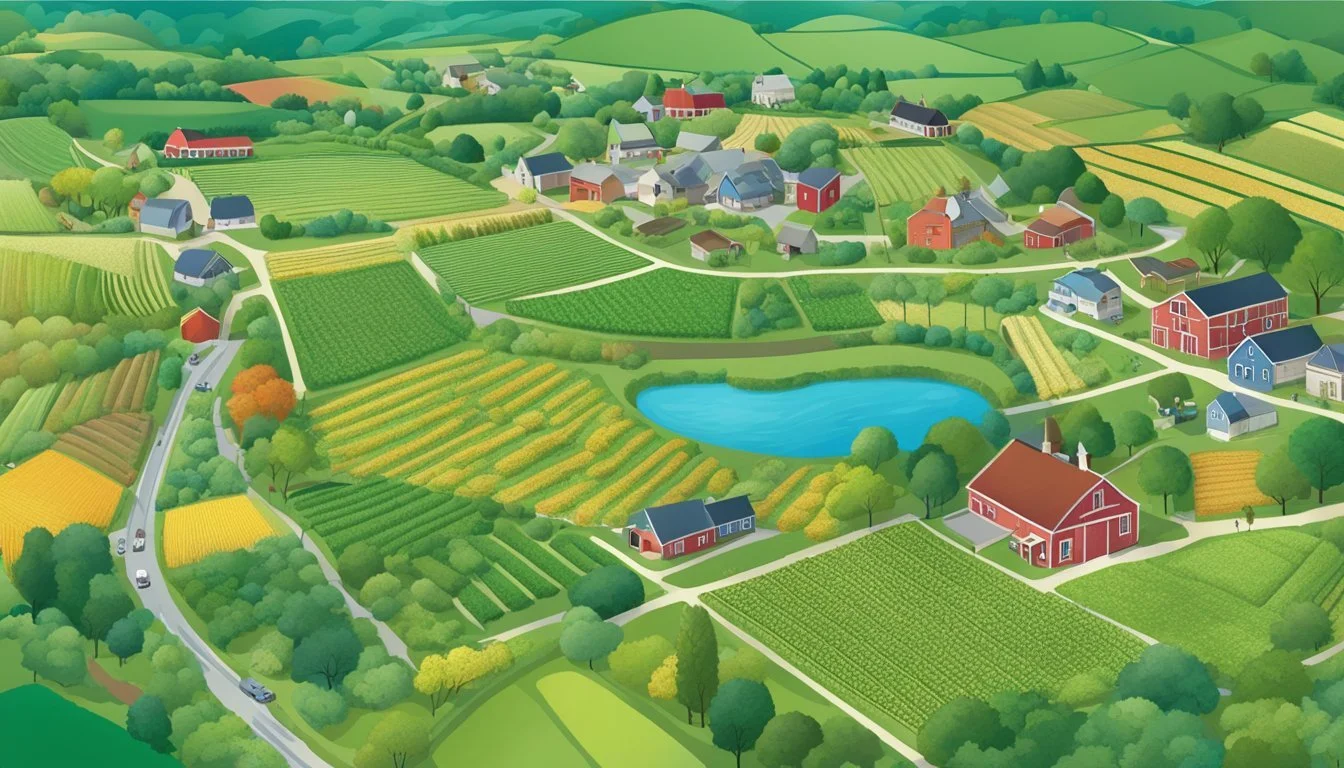Guide to Farming in Connecticut
Essential Tips for Successful Agriculture
This Article is Part of Our State by State Farming Guide
Connecticut's agricultural landscape is diverse and productive, steeped in a rich farming tradition. It's a state where the agricultural sector has proven resilient and dynamic, with a variety of crops and produce sustaining local communities and contributing to the economy. Farms in Connecticut yield a range of products, from dairy goods and eggs to vegetables and flowers. Notably, the state's greenhouse and nursery products lead in terms of agricultural output.
Farming in Connecticut adapts to both tradition and evolving trends. Local farmers grow staple crops like corn and hay, while also dedicating land to burgeoning markets for organic vegetables and specialty flowers. In addition to the land-based agriculture, Connecticut has a vibrant seafood industry, with shellfish (What wine goes well with shellfish?) such as clams (how long do clams last?) and oysters being important to coastal economies.
Farmers in Connecticut are supported by a network of resources, including local guides that connect consumers to farms and fresh produce, and state initiatives that emphasize farm business growth and inclusion. Agricultural practices in the state balance between modern advancements and sustainable techniques, ensuring that Connecticut's farming remains a vital part of its identity and future.
History and Importance of Connecticut Agriculture
Connecticut's agricultural sector has a legacy rooted in transformation and resilience, significantly contributing to the state's economic and social fabric. Farming practices and economic contributions highlight the enduring relevance of agriculture in this region.
Evolution of Farming Practices
From the 18th century onwards, agriculture was a cornerstone for Connecticut residents. Early farming in Connecticut centered around family-owned plots, where diverse crops were cultivated. Yet, with the advent of the industrial age in the mid-19th century, there was a shift from an agrarian to an industrial economy. Despite this shift, contemporary Connecticut has seen a steadfast although reduced number of farms, now fewer than 5,000. Present-day farming techniques reflect a synthesis of tradition and innovation, with an emphasis on sustainability and efficiency. The focus extends to new markets such as organic produce and specialty crops alongside traditional dairy and livestock production.
Agricultural Contributions to the Economy
Connecticut's farms, though smaller on average compared to other states, play a substantial role in its economy. Agriculture supports around 22,000 jobs across production, processing, and agribusiness sectors. The state's 5,500 farms span 380,000 acres, with an average farm size of 69 acres, and collectively contribute approximately $4 billion annually. Additionally, over 70,000 acres dedicated to shellfish farming in coastal waters bring in over $30 million in sales every year. Thus, despite facing challenges, farmers and agricultural businesses remain key players in Connecticut’s economy, exemplifying agriculture’s importance.
Choosing Crops and Livestock
In Connecticut, agriculturalists need to navigate the state's diverse climate and soil conditions to choose the most suitable crops and livestock. This decision impacts sustainability, profitability, and compliance with local zoning regulations.
Suitable Crops for Connecticut's Climate
Connecticut's climate is conducive to growing a variety of crops. The state has a relatively long growing season that supports:
Vegetables: Including leafy greens, tomatoes, and peppers.
Corn: Particularly sweet corn, a popular choice in local markets.
Hay: Often used as feed for livestock within the state.
Farmers should consider soil quality, local microclimates, and market demand when selecting crops for cultivation.
Dairy and Livestock Farming
Dairy farming is a significant part of Connecticut agriculture. Farmers in Connecticut:
Cows: Manage dairy herds to produce about 30 percent of the fluid milk consumed locally.
Cattle: Raise beef cattle for meat production in addition to dairy.
Livestock zoning is guided by local regulations, which were made more accessible after the state provided updated guidance in 2012.
Organic and Specialty Farming
Organic and specialty farming represent growing sectors within Connecticut's agricultural landscape. These include:
Organic Foods: There is a demand for organically grown vegetables, fruits, and grains.
Specialty Crops: Such as herbs, flowers, and heirloom varieties that cater to niche markets.
Farmers interested in these areas must adhere to specific organic certification requirements and consider direct marketing strategies to reach consumers.
Agricultural Business Management
Managing an agricultural business in Connecticut requires a nuanced understanding of the market economy, innovative revenue strategies, and a grasp of the prevailing farm and food policies. The following subsections delve deeper into each aspect, providing guidance for the successful operation of a farm enterprise.
Economic Strategies for Farmers
Farmers in Connecticut must develop sound economic strategies to ensure the viability of their operations. By crafting a detailed business plan as suggested by the UConn Extension's Farm Risk Management program, agricultural businesses can secure loans and grants more effectively. Moreover, understanding the specific market demands and pricing models within Connecticut's economy helps to position these businesses for success.
Key Considerations:
Business Planning: Essential for securing financial aid and guiding operations.
Market Research: Understanding demand to inform crop selection and pricing.
Exploring Alternative Revenue Streams
To enhance their economic resilience, farms should explore alternative revenue streams beyond traditional farming practices. Agritourism, value-added products, and direct-to-consumer sales models are examples of diversification. This not only broadens the customer base but also taps into new markets, often leading to job creation within the agricultural sector.
Alternatives to Consider:
Agritourism: Hosting events, farm tours, or overnight stays.
Value-Added Products: Processing crops into goods like jams, cheeses, or preserved foods.
Direct Sales: Establishing CSA programs or selling at farmers' markets.
Understanding Farm and Food Policies
Navigating the regulations and policies that govern Connecticut’s agricultural sector is crucial for compliance and taking advantage of government programs. Familiarity with publications such as "Planning for Agriculture: A Guide for Connecticut Municipalities" helps agricultural businesses stay informed about policies that can impact their operation. Compliance with these rules is not only a legal necessity but often provides pathways to grants and additional support services.
Policy Resources:
State Guides: Publications on municipal planning and state-specific regulations.
Government Programs: Information on available support, such as Farm Viability Grants.
Farm Infrastructure and Technology
The agricultural landscape in Connecticut is continuously evolving, integrating advanced equipment and technologies to increase efficiency and productivity. Robust farm infrastructure and cutting-edge technologies play critical roles in modern farming practices within the state.
Innovative Farming Equipment
Farmers in Connecticut are increasingly adopting innovative equipment to meet the demands of precision agriculture. GPS technology and automated systems are at the heart of this transformation, enabling farmers to optimize field operations to save time and resources. They use drones for field monitoring and data collection, which leads to informed decision-making through analysis of real-time crop conditions. Precision farming tools such as smart tractors and planting monitors enhance the accuracy of seed placement and crop management, critically improving yields and reducing waste.
Role of Greenhouses and Anaerobic Digesters
Greenhouses play a pivotal role in Connecticut agriculture by providing controlled environments for year-round crop production. Farmers use sophisticated climate control systems to manage temperature, humidity, and lighting, ensuring optimal growth conditions for a variety of crops. These structures help protect plants from unpredictable weather, pests, and diseases, and are essential for extending the growing season.
Anaerobic digesters are an innovative technology gaining traction among Connecticut farmers. Such systems convert farm waste into renewable energy and valuable byproducts. They efficiently manage manure and other organic waste, while producing biogas that can be used for heating, electricity, or fuel. This not only helps in waste management but also contributes to the farm’s energy self-sufficiency. Anaerobic digesters, thus, represent a key step towards sustainable farm infrastructure.
Local and Global Market Dynamics
Connecticut's agricultural sector actively participates in local and global markets, balancing supply chain dynamics while also contributing to exports. The state's approach to agriculture emphasizes direct-to-consumer sales, efficient product distribution, and outreach to international markets.
Participation in Farmers Markets
Farmers Markets serve as vital platforms for Connecticut farmers to sell directly to consumers. They offer a diverse range of food and produce, with an emphasis on dairy products and other fresh items. The establishment of these markets is supported by a comprehensive guide that helps farmers navigate regulations and tap into supplemental food programs.
Supply Chain and Distribution
Proper supply chain and distribution systems are crucial for delivering Connecticut's agricultural products, including seafood, dairy products, and fresh produce, to the markets efficiently. Local farms like Wades Farm Fresh and Willow View Farm demonstrate the importance of robust distribution networks that enable year-round access to farm products within the state.
Exporting Connecticut Agriculture
Despite its small size, Connecticut plays a role in the export market for agricultural goods. The state’s strategic location in the Northeast allows for the distribution of diverse agricultural products beyond its borders. Farmers and producers are tapping into growing opportunities to export their goods, expanding Connecticut’s reach in global agricultural trade.
Sustainability and Environmental Practices
In Connecticut, the adoption of sustainable farming practices and the navigation of climate change impacts are crucial for the longevity of agriculture. The emphasis is on maintaining environmental health while supporting the economy.
Implementing Sustainable Farming
Sustainability in agriculture is a priority for Connecticut farms. Initiatives such as the Climate Smart Farming program highlight the state's efforts toward supporting sustainable practices. They introduce methods like:
Soil Management: Cover cropping and crop rotation enhance soil health.
Water Management: Adoption of efficient irrigation systems and rainwater harvesting to mitigate water scarcity.
Pest Management: Integrated Pest Management (IPM) strategies reduce reliance on chemical pesticides.
Local entities also promote practices like biochar incorporation, which supports soil amendment and carbon sequestration. Together, these eco-friendly techniques aim to improve long-term viability and environmental footprint of Connecticut's agricultural lands.
Climate Change Impacts on Agriculture
Agriculture in Connecticut faces a range of challenges from climate change, including extreme weather events and shifting growing seasons. Farmers are encouraged to adapt by:
Adopting Resilient Crops: Choosing varieties that are more tolerant to climatic stress.
Season Extension: Utilizing greenhouses or hoop houses extends the growing season.
Research ties the benefits of forest and farmland in combating climate change, such as carbon storage and flood control, to agricultural health. The mitigation of these climatic impacts is essential for agriculture to thrive in Connecticut's evolving environment.
Community and Education
In Connecticut, the intersection of community and education fosters a robust agricultural framework through targeted educational programs and the support of key agricultural organizations.
Agricultural Education Programs
Connecticut's educational institutions, such as Killingly High School, offer agriculture education programs that prepare students for future careers in agriculture. Programs may include classroom instruction paired with hands-on experiences in fields, greenhouses, or on-site farms. In addition to primary education, organizations like CT NOFA (Connecticut Northeast Organic Farming Association) and UConn Extension provide ongoing training for individuals at various stages of their agricultural careers.
Key Educational Entities:
Public Schools: Essential for early agricultural education
UConn Extension: Offers advanced training and support
CT NOFA: Provides organic farming principles and techniques
Role of Agricultural Organizations
Agricultural organizations play a pivotal role in uniting the community and promoting education. CCM (Connecticut Conference of Municipalities) and farmland preservation groups work to ensure that local agricultural policies support community farms and education. Through initiatives such as "Put Local on Your Tray" and "Celebrate Agriculture," these organizations strive to embed agricultural awareness within the community ethos.
Main Functions:
Policy Advocacy: Supportive municipal planning for agriculture
Community Engagement: Programs that connect residents with local food systems
Educational Outreach: Promoting farm-to-school activities
The synergy between educational initiatives and agricultural organizations cultivates a knowledgeable community dedicated to sustaining and enhancing Connecticut's agricultural heritage.
Agricultural Tourism and Direct Sales
Connecticut offers a diverse range of farm-based recreational activities and direct sales opportunities. These ventures help bridge the gap between producers and consumers, reinforcing the state's agrarian economy and fostering a culture of local consumption.
Promoting Farm-to-Table Experiences
Farm-to-table restaurants in Connecticut anchor the culinary scene by sourcing ingredients directly from local farms. This initiative not only supports the local farming community but also provides diners with fresh, seasonal produce that encapsulates the essence of Connecticut's agricultural offerings. Restaurants and farms collaborate to create menus that showcase the freshest flavors, with chefs often highlighting the provenance of their ingredients to educate and inform patrons about the benefits of local sourcing.
Pick-Your-Own Farms and Agritourism
Agritourism experiences, including pick-your-own fruit farms, are a staple of Connecticut's agricultural appeal. These farms offer a hands-on approach to agriculture by inviting visitors to harvest their own produce. Visitors gain insight into the farming process and actively participate in the local food system.
Strawberries, blueberries, and apples: Common crops available for picking
Family activities: Seasonal events and corn mazes that enhance the farm visit
Such direct engagement is a critical component of direct sales for farms, creating an integrated experience that combines leisure with the acquisition of farm-fresh goods. Through these interactions, farms not only sell products but also provide educational and entertainment value, reinforcing their economic stability and fostering community involvement.
Policy, Advocacy, and Future Challenges
In the landscape of Connecticut's agriculture, active collaboration with policy makers and adaptation to new regulations are crucial for the industry's growth and sustainability.
Engagement with the Department of Agriculture
The Connecticut Department of Agriculture, under the leadership of Commissioner Bryan P. Hurlburt, offers guidance and resources to farmers navigating the evolving agricultural policies. Advocacy within the state is essential for ensuring that the voices of farmers are heard and that the policies enacted by the department provide effective support for the agriculture sector. The collaboration entails farmers staying informed about policy changes and engaging in dialogue with the department to promote favorable conditions for farming in Connecticut.
Adapting to New Regulations and Market Trends
Farmers face the challenge of adapting to new regulations which often reflect market trends and consumer demands, such as the growing interest in locally sourced and sustainable agriculture. Keeping abreast of these trends is necessary for Connecticut farmers, who must adjust their practices accordingly to stay competitive. Regulations on land use, environmental compliance, and new technologies represent a significant focus for farmers who need to navigate these policies while maintaining their operations. This adaptive strategy can ensure the viability of farms in Connecticut amidst the changing agricultural landscape.








